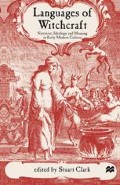Abstract
This chapter is about storytelling, about two stories told by two seventeenth-century Scottish women accused of witchcraft. The stories these women told are fairy stories, in every sense; stories that had been told before, stories that pass the time, stories that express cultural truths, stories that circulate in oral form and baffle those who wish to add them to the written lexicon, and above all, stories about fairies. I want to argue here that Scottish witches told stories about fairies not out of any straightforward belief in fairies, not out of any longing to satisfy their interrogators, but because the court setting allowed these women to talk about feelings, experiences, and desires that could never normally be given a hearing within their cultures. The women might have told the stories before, but here they were giving their stories to their entire world. The fairy stories I am going to be discussing are the sounds of silence in two senses. Firstly, they represent a moment when a normally silent group — women of the lower orders — makes an appearance as storytellers on the historical stage. Secondly, they represent the things those women could not ordinarily say.
Preview
Unable to display preview. Download preview PDF.
Notes
See also and more briefly, G. F. Black, Examples of Printed Folklore Concerning the Orkney and Shetland Islands, Folklore Society, vol. 3 (London, 1903), p. 55.
Angela Bourke, ‘Reading a Woman’s Death: Colonial Texts and Oral Tradition in Nineteenth-Century Ireland’, Feminist Studies, 21 (1995).
Barbara Rieti, Strange Terrain: The Fairy World in Newfoundland, St John’s, Newfoundland, no. 45, 1991, p. 21.
In other stories, trowis are not the dead, but the keepers of the dead: see Alan Bruford, ‘Trolls, Hillfolk, Finns and Picts: The Identity of the Good Neighbours in Orkney’, in Peter Narvaez (ed.), The Good People: New Fairylore Essays (New York, 1991), pp. 116–41.
Robert Kirk, The Secret Commonwealth of Elves and Fairies, ed. Stuart Sanderson (Cambridge, 1976), p. 73: ‘so are they seen to wear Plaids and variegated garments in the Highlands of Scotland’.
On Scottish ancestry and kinship, see
Jenny Wormald, Court, Kirk and Community: Scotland, 1470–1625 (Edinburgh, 1981).
Angela Bourke, ‘Fairies and Anorexia: Nuala Ni Dhomhnaill’s “Amazing Grass”’, Proceedings of the Harvard Celtic Colloquium, 13 (1993), pp. 32–5.
This case is recounted many times in different places, from many different points of view, due to Weir’s political importance: John Lamont, Diary, ed. G. R. Kinloch (Edinburgh, 1830), pp. 271–2
G. Sinclair, Satans Invisible World Discovered (Edinburgh, 1789), pp. 152–3
Robert Law, Memorialls, ed. C. K. Sharpe (Edinburgh, 1818), p. 27
Judith Herman, Father-Daughter Incest (Cambridge, MA, 1981), pp. 97, 98.
For other instances of fairies as the dead or as guardians of the dead, see note 3; and also Lewis Spence, The Fairy Tradition in Britain (London, 1948).
Julie Osborn, Psychological Effects of Child Sex Abuse on Women, Social Work Monographs (Norwich, 1990), app. 3, p. 38.
On Cinderella and the mother, see Marina Warner, From the Beast to the Blonde: On Fairytales and their Tellers (London, 1994), pp. 201–17.
Janice Haaken, Pillar of Salt: Gender, Memory and the Perils of Looking Back (London, 1998), pp. 2–5.
Editor information
Editors and Affiliations
Copyright information
© 2001 Diane Purkiss
About this chapter
Cite this chapter
Purkiss, D. (2001). Sounds of Silence: Fairies and Incest in Scottish Witchcraft Stories. In: Clark, S. (eds) Languages of Witchcraft. Palgrave, London. https://doi.org/10.1007/978-0-333-98529-8_5
Download citation
DOI: https://doi.org/10.1007/978-0-333-98529-8_5
Publisher Name: Palgrave, London
Print ISBN: 978-0-333-79349-7
Online ISBN: 978-0-333-98529-8
eBook Packages: Palgrave History CollectionHistory (R0)

